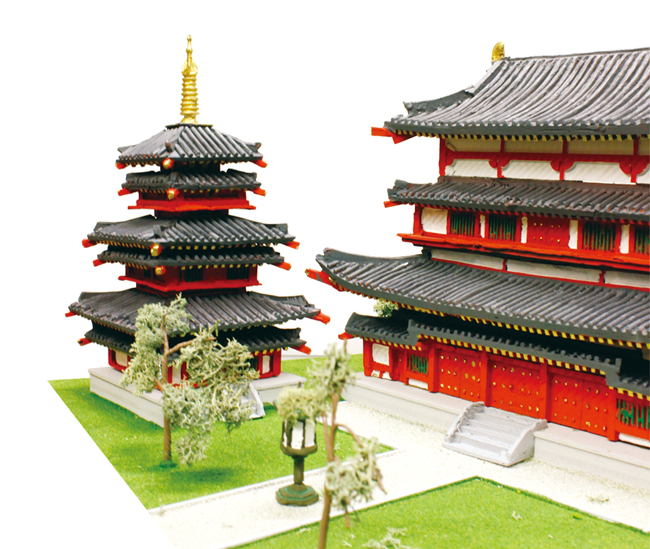
当たり前に日本人として生きてきた。でも海外に出てから、日本について何も知らないことに気が付いた。そこで、日本が世界に誇る世界遺産について建立年順に勉強しようと思う。興味がある人も、そうでない人も、しばしお付き合いを。
I’ve lived my whole life as a Japanese person, but when I went overseas I realised I know practically nothing about Japan. So now I’m learning about Japan’s World Heritage Sites, from oldest to newest. Those who are interested, and even those who are not, come along for the ride.

撮影協力 / メルボルン総領事館 Thanks to the Consulate-General of Japan, Melbourne
○○○○○ 薬師寺 日中仏教界の百世之師をまつり次世代を育む寺院 ○○○○○
1998年に古都奈良の文化財が世界文化遺産に登録されました。登録されているのは、東大寺(とうだいじ)、興福寺(こうふくじ)、春日大社(かすがたいしゃ)、元興寺(がんごうじ)、薬師寺、唐招提寺(とうしょうだいじ)、平城宮跡、春日山(かすがやま)原始林。登録資産616.9ヘクタールと、境保護区域と歴史的環境調整区域を加えた2,501.5ヘクタールです。自然と調和した景観や地中に埋もれた遺跡など特色ある遺産です。登録の決め手は、奈良時代の寺院建築様式を今に伝えていることや、8世紀の中国や朝鮮半島との文化的交流がうかがえ、日本独自の神道思想や仏教文化が今も息づいていることなどです。
今回はその中のひとつ、薬師寺(やくしじ)を紹介します。奈良県奈良市西ノ京町にある薬師寺は、興福寺と共に約1,350年前、唐からインドまでシルクロードを旅して経典657部などを持ち帰り、『大般若経(だいはんにゃきょう)』にまとめた玄奘三蔵(げんじょうさんぞう)を始祖とする法相宗(ほっそうしゅう)の大本山です。ちなみに、玄奘三蔵は三蔵法師(さんぞうほうし)とも呼ばれ、『西遊記』の三蔵法師のモデルになった人でもあります。
薬師寺は、680年に天武(てんむ)天皇によって藤原京に創建されましたが、718年の平城遷都(へいじょうせんと)に伴い現在の場所に移転しました。藤原京に建てられた薬師寺と現在の薬師寺の発掘調査で、両伽藍の建物の規模や位置関係などがほぼ等しいことが分かりました。約1,300年前の測量技術の精密さにビックリ。ちなみに、薬師寺の伽藍は金堂、講堂などを中心に、東塔と西塔の2つの三重塔を配する独特の配置で『薬師寺式伽藍配置』と呼ばれています。しかし、数度の災害と1528年の兵火により、当時からある建造物は東塔のみになってしまいました。その後、第124世管主の高田好胤(たかだこういん)が中心となって行った写経勧進による白鳳(はくほう)伽藍復興事業が進められ、金堂は1976年、西塔は1981年、中門は1984年に復興されました。
東塔は、一見六重の塔に見える三重塔で『凍れる音楽』と称されている安定感のある美しい塔です。この「凍れる音楽」は、日本美術を高く評価し、海外に紹介したアーネスト・フェノロサの言葉とされていますが、『建築は凍れる音楽』というフレーズ自体、以前からドイツにゴシック様式の建造物を例えた言葉としてあったようです。現在東塔は、約10年かけて行われた110年ぶりの解体修理が2020年竣工し、美麗な姿がよみがえっています。
天平時代の華麗な彩色に目を奪われるのが、東塔と対になっている西塔。よく見ると東塔よりも少し高くなっていますが、これは年月の経過による材木のたわみや基礎の沈下を計算したもの。再建に当たった文化財保存技術者で『最後の宮大工』と呼ばれた西岡常一(にしおか つねかず)によると、500年後には西塔も東塔と同じ高さに落ち着くとか。500年後に伝える仕事、壮大ですよね。
定例法話会や写経会、小中学生対象の夏休み寺子屋、高校生から大学院生を対象にした実際に寺院の伝統行事に参加する青年衆、多様なジャンルの音楽家による奉納コンサートなど、一般の人々が気軽に参加でき、仏教を体感できる行事が多い、開かれた寺院です。
次回は、薬師寺と同じく古都奈良の文化財のひとつ、平城宮跡を紹介します。
○○○Yakushi-ji: a temple that is an iconic figure in Chinese and Japanese Buddhism○○○
In 1998, the ‘Historic Monuments of Ancient Nara’ were registered as World Heritage sites. These are Todai-ji, Kofuku-ji, Kasuga-taisha, Gango-ji, Yakushu-ji, Toshodai-ji, the ruins of Heijo Palace, and Kasugayama Primeval Forest. The heritage-listed area is 616.9 hectares, while the buffer zone and ‘historic environment harmonisation area’ make up a further 2,501.5 hectares. The area is a unique piece of heritage. It was chosen for the list due to the Nara period architectural style of its structures, and its evidence of 8th century cultural exchange with China and Korea that influenced Japan’s unique mix of Shinto and Buddhist ideas.
This time I introduce one of these monuments: Yakushi-ji, located in Nishinokyo-cho, Nara City, Nara Prefecture. 1,350 years ago, Xuanzang travelled the Silk Road from China to India, and brought back 657 Buddhist texts. He compiled ‘The Perfection of Wisdom Sutra’ and made Yakushi-ji and Kofuku-ji the head temples of the Hosso sect of Buddhism. (He also was the inspiration for the monk character in ‘Journey to the West’, also known as ‘Monkey’ in the English-speaking world.)
Yakushi-ji was established in Fujiwara-kyo by Emperor Tenmu in the year 680, but in 718 it was moved due to the relocation of the capital. Excavations of the Yakushi-ji site at Fukuwara-kyo and today’s Yakushi-ji have revealed that both temples were built with almost precisely the same scale and structure. It’s amazing how exact the measuring techniques of 1,300 years ago were! The distinctive arrangement of the temple, centering on the main hall (‘Kondo’) and lecture hall (‘Kodo’) and with a three-storey pagoda to the east and west, is now known as ‘yakushiji-style’. Unfortunately, due to fire caused by war in 1528 as well as several natural disasters, the only original structure today is the East Pagoda (‘To-to’). Later, thanks to the Hakuho Temple Restoration Project led by Takada Koin, 124th abbot of Yakushi-ji, the main hall was restored in 1976, the West Pagoda (‘Sai-to’) in 1981, and the central gate (‘Chu-mon’) in 1984.
The serenely beautiful East Pagoda looks like it has six storeys but in fact only has three. It was likened to ‘frozen music’ by Ernest Fenollosa, a great admirer and introducer of Japanese art to the outside world (though the phrase ‘architecture is frozen music’ is of German origin).
The eye-catching West Pagoda has magnificent Tempyo period coloration. Close examination reveals it is slightly taller than the East Pagoda, but that is because of the latter’s wood warping and foundations sinking over centuries. According to Nishioka Tsunekazu, an expert in the preservation of ancient shrines and temples, after 500 years both towers will be the same height. Isn’t that amazing, to do work for 500 years hence?
Yakushi-ji is a very open temple, holding many events in which ordinary people can take part and experience Buddhism: sermons and the hand-copying of sutras; ‘temple school’ for primary and junior high school students during summer vacation; ‘Seinen-shu’,a program in which high school and university students can take part in traditional temple events; and concerts in dedication to the gods by musicians of many genres.
Next we introduce the Heijo Palace ruins, another ‘Historic Monument of Ancient Nara’.

